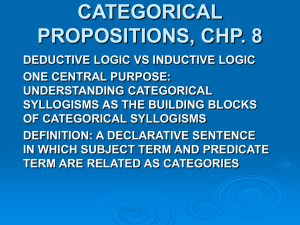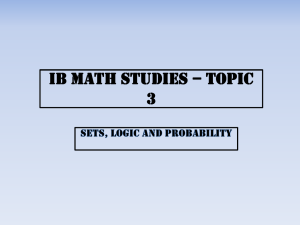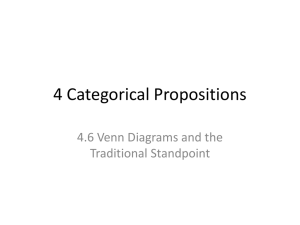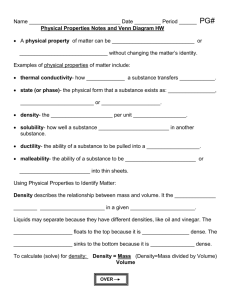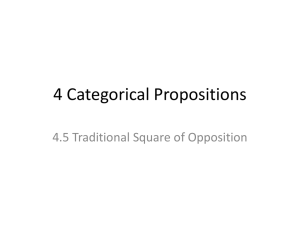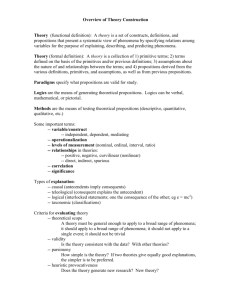Approaches to Categorical Statements Hurley (12e) Baronett (2e
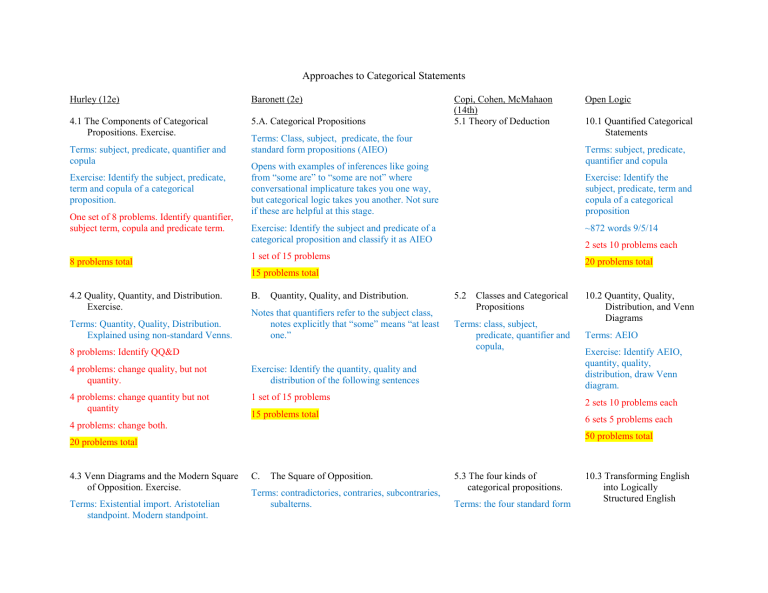
Approaches to Categorical Statements
Hurley (12e) Baronett (2e)
4.1 The Components of Categorical
Propositions. Exercise.
Terms: subject, predicate, quantifier and copula
Exercise: Identify the subject, predicate, term and copula of a categorical proposition.
One set of 8 problems. Identify quantifier, subject term, copula and predicate term.
8 problems total
4.2 Quality, Quantity, and Distribution.
Exercise.
Terms: Quantity, Quality, Distribution.
Explained using non-standard Venns.
8 problems: Identify QQ&D
4 problems: change quality, but not quantity.
4 problems: change quantity but not quantity
4 problems: change both.
20 problems total
4.3 Venn Diagrams and the Modern Square of Opposition. Exercise.
Terms: Existential import. Aristotelian standpoint. Modern standpoint.
5.A. Categorical Propositions
Terms: Class, subject, predicate, the four standard form propositions (AIEO)
Opens with examples of inferences like going from “some are” to “some are not” where conversational implicature takes you one way, but categorical logic takes you another. Not sure if these are helpful at this stage.
Exercise: Identify the subject and predicate of a categorical proposition and classify it as AIEO
1 set of 15 problems
15 problems total
B. Quantity, Quality, and Distribution.
Notes that quantifiers refer to the subject class, notes explicitly that “some” means “at least one.”
Exercise: Identify the quantity, quality and distribution of the following sentences
1 set of 15 problems
15 problems total
C. The Square of Opposition.
Terms: contradictories, contraries, subcontraries, subalterns.
Copi, Cohen, McMahaon
(14th)
5.1 Theory of Deduction
5.2 Classes and Categorical
Propositions
Terms: class, subject, predicate, quantifier and copula,
5.3 The four kinds of categorical propositions.
Terms: the four standard form
Open Logic
10.1 Quantified Categorical
Statements
Terms: subject, predicate, quantifier and copula
Exercise: Identify the subject, predicate, term and copula of a categorical proposition
~872 words 9/5/14
2 sets 10 problems each
20 problems total
10.2 Quantity, Quality,
Distribution, and Venn
Diagrams
Terms: AEIO
Exercise: Identify AEIO, quantity, quality, distribution, draw Venn diagram.
2 sets 10 problems each
6 sets 5 problems each
50 problems total
10.3 Transforming English into Logically
Structured English
Standard Venns, existential fallacy
8 problems: Draw the venn diagrams for the following
15 problems: evaluate 1prem args from the boolean standpoint using the modern square of opposition.
15 problems: Use venn diagrams to evaluate the arguments in the previos section. (not really that different than the last section, but ok.)
4 problems: Identify the remaining four forms of the existential fallacy.
42 problems total
5 problems: variations on saying what the relationship between two sentences is, or writing the sentence that has a certain relationship to another.
6 problems: given the truth value of one kind of sentence, find the truth value of another.
5 problems: variations on saying what the relationship between two sentences is, or writing the sentence that has a certain relationship to another.
24 problems: given the truth value of one kind of sentence, find the truth value of another.
50 problems total propositions (AIEO)
Exercise: Identify the subject and predicate of a categorical proposition and classify it as
AIEO
One set of 10 problems
10 problems
4.4 Conversion, Obversion, and
Contraposition. Exercise.
Terms: conversion, obversion, contraposition, complement, and fallacies of illicit conversion and contraposition.
Uses Venn diagrams. Does not discuss conversion by Limitation.
12 problems: given statements with variables and truth values, fill in the blank on tables with operations, new statements, and truth values
4 problems: convert the following
4 problems: obvert the following
4 problems: contrapose the following
20 problems: evaluate the following 1
D. Conversion, Obversion and Contraposition.
Does not use Venn diagrams. Discusses
Conversion by Limitation. Uses the awkward terms “convertend” and “obvertend”
23 problems total
5.4 Quantity, Quality and
Distribution.
10 problems
Problem areas covered:
Nonstandard Verbs, Implicit
Noun Phrases, Unexpressed
Quantifiers, Nonstandard
Quantifiers, Singular
Propositions, Adverbs and
Pronouns
Conditional Statements,
Exclusive Propositions,
``The Only''
2 sets 10 problems each with simple translations
2 sets 10 problems each with more complicated translations
40 problems total
10.4 Conversion, Obversion and Contraposition.
Uses Venn diagrams. Does not discuss conversion by
Limitation. Does not talk about convertend and obvertend.
2 sets 10 problems each filling in a chart
2 sets of 10 problems writing in the converse, obvserse or contrapositive.
2 sets of 10 problems evaluating arguments
premise arguments using the 3 processes. Name the fallacy for bad ones.
44 problems total.
4.5 The Traditional Square of Opposition.
Exercise.
Says that on the trad interp, universal statements have existential import when the objects are known to exist. Builds an extra level of charity into the interpretation.
Gets history wrong
Makes you evaluate inferences with “…is true” and “it is false that…” in premise and conclusion.
24 problems: given the truth value of one statement, evaluate the truth value of another.
15 problems evaluate arguments using trad square of opposition.
10 problems evaluate arguments using trad square of opposition.
20 problems table of processes and truth values using trad standpoint.
15 problems evaluate arguments using trad square of opposition.
15 problems evaluate arguments using trad square of opposition. show intermediate inferences
99 problems total.
4.6 Venn Diagrams and the Traditional
Standpoint. Exercise.
E. Existential Import
Gets history wrong by saying that the traditional interpretation asserts existential import for particular & all universal statements.
F. Modern Square of Opposition
Introduces some Boolean, with symbols for
5.5 The Traditional Square of Opposition
Mentions that the square does not work for necessary sentences—a necessary sentence and its contrary can’t be both false. Stipulates that we are only dealing with contingent sentences here.
Calls the members of a relationship of subalternation
“corresponding statements”
12 problems
5.6 Further Immediate
Inferences
60 problems total
10.5 The Traditional
Square of Opposition
Avoids discussing existential import at all, for now. Uses only examples where it doesn’t come up
2 sets of 10 problems identify the relationship between sentences.
2 sets of 10 problems writing a new proposition that stands in a specified relationship to a given one.
2 sets of 10 problems: given the truth value of one statement, find the truth value of another
2 sets of 10 problems: evaluate argument problems
80 problems total
10.6 Existential Import and the Modern Square of
A modified Venn diagram method is created to evaluate the traditional statement. It uses a circled x in the universal forms to indicate that “if something exists, it exists here.” A kind of unfalsifiable existence claim. This is then used to prove the trad square of opposition
(in the mistaken way H understand it) and evaluate inferences.
10 problems evaluate arguments using modified Venn method
15 problems evaluate arguments using modified Venn method, state intermediate stems and fallacies.
25 problems total.
4.7 Translating Ordinary Language
Statements into Categorical Form.
Exercise.
Ten problem areas: missing nouns, nonstandard verbs, singular propositions, adverbs and pronouns, unexpressed quantifiers, nonstandard quantifiers, conditional statements, exclusive propositions, sentences with “the only” and exceptive propositions.
No separate discussion of sentences requiring two transformation or “it is false that”
For adverbs and pronouns has examples using:
Always
Never
Nowhere
Whoever
Whenever intersection, empty set, and complement.
Introduces Venn diagrams for the first time, adding the Boolean notation to it.
G. Conversion, Obversion and Contraposition revisited
Applies Venn diagrams to these topics.
45 problems total
Terms: conversion, obversion, contraposition, complement, and fallacies of illicit conversion and contraposition.
Does not use Venns.
65 problems
Opposition
20 evaluate the argument problems
4 proof problems
24 problems total
5.7 Existential import and the interpretation of categorical propositions
Asserts falsely that no one would ever deny existential import to O statements.
13 problems
where she
What she
Exercise set 1, 60 problems: translate the following into standard form
Exercise set 2, 10 problems: correct mistakes in translated exercises
Exercise set 3, 10 problems translate and evaluate arguments.
80 problems total.
H Venn Diagrams and the Traditional Square
Uses an x with a circle around it to indicate hypothetical existence for universal propositions.
Then, in evaluating the propositions, asks to determine if the thing the term refers to exists.
(Why not just use a regular x? When we evaluate arguments with particular statements, we have to check if the objects exist. The only exception would be if you are doing a purely formal analysis. But then couldn’t we also do a purely formal analysis for universal statements with existential import.)
20 problems total
I. Translating Ordinary Language into
Categorical Propositions.
Eleven problem areas: missing nouns, nonstandard verbs singular propositions, adverbs and pronouns, “it is false that” implied quantifiers, nonstandard quantifiers, conditional statements, exclusive propositions, “the only,” and propositions requiring two translations.
No discussion of exceptive propositions.
For adverbs and pronouns has examples using:
5.8 Symbolism and diagrams for categorical propositions.
Only here do we get Venns.
20 problems
318 problems in the whole chapter.
Wherever
Whenever
Whoever
What goes
Exercises: 75 translation exercises.
243 problems total 130 problems total 274 Problems total
